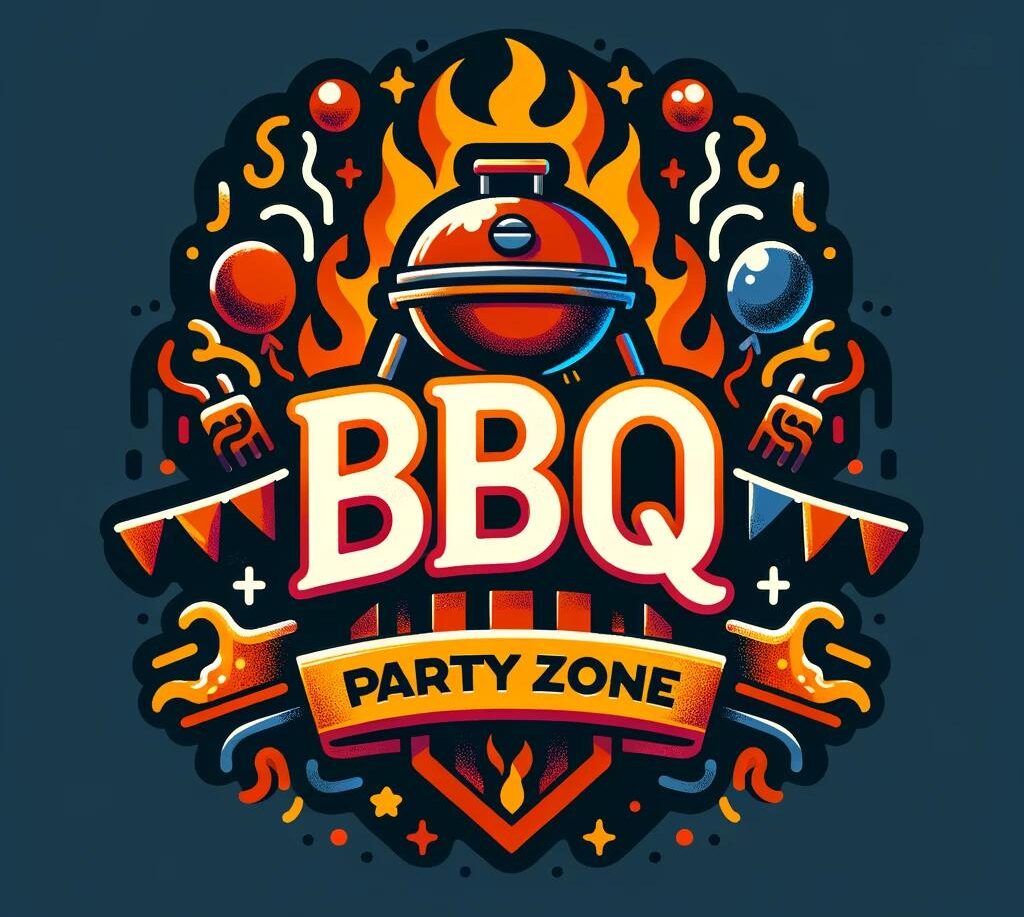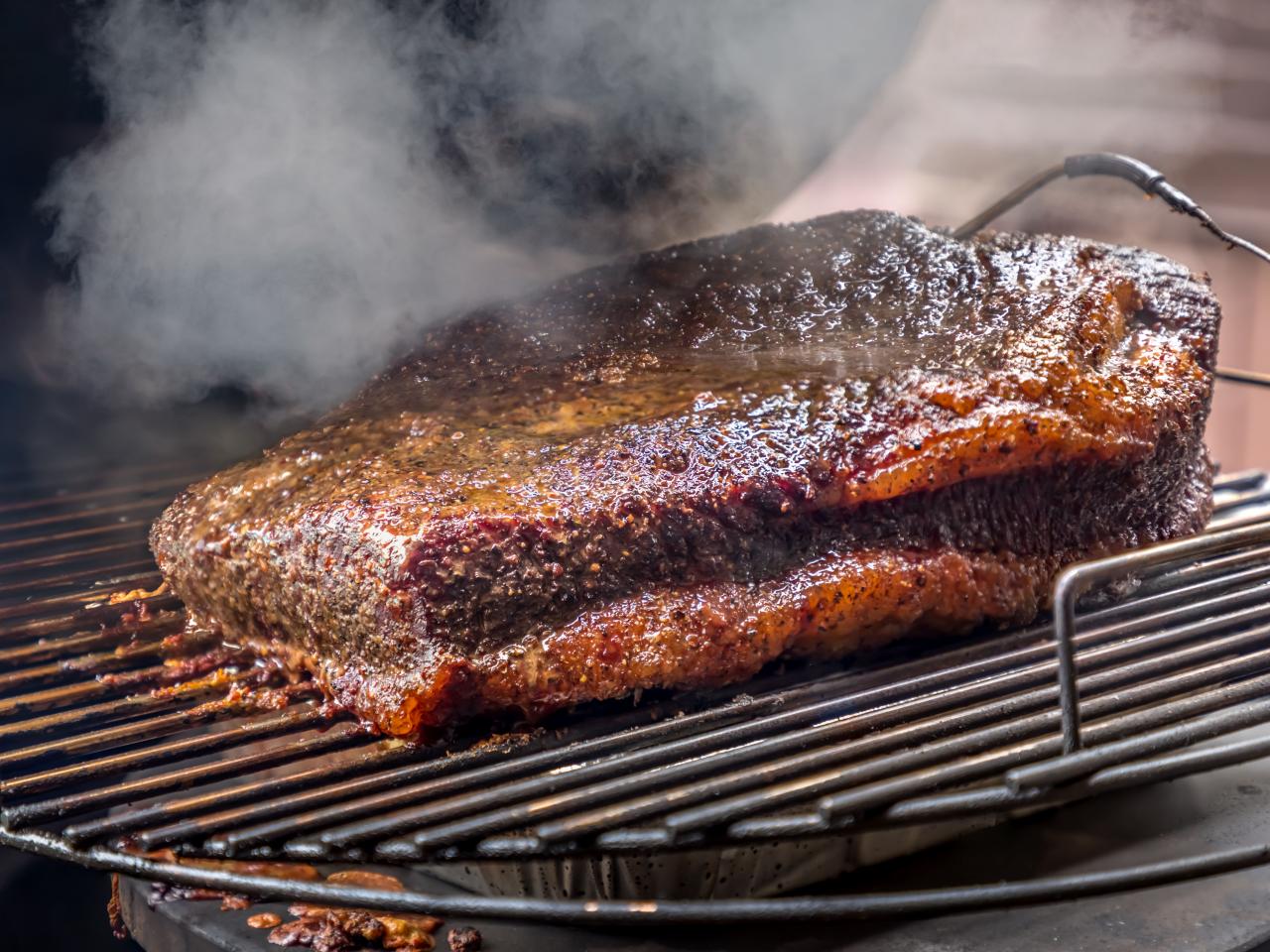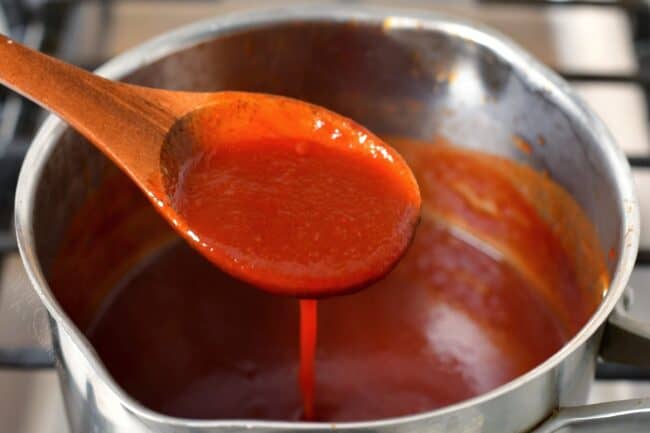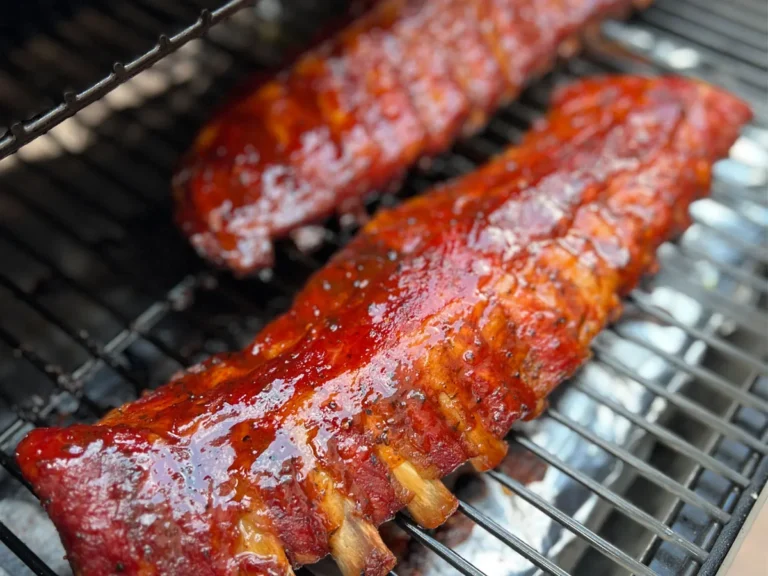Best Methods on How to Make Brisket BBQ
Curious about how to turn a tough piece of meat into a tender, smoky delight? Mastering How to Make Brisket BBQ is a rite of passage for any grill enthusiast. From selecting the right cut to the final slice, I’ll guide you through each step, unraveling the mysteries of rubs, smoking temps, and the all-important ‘rest’.
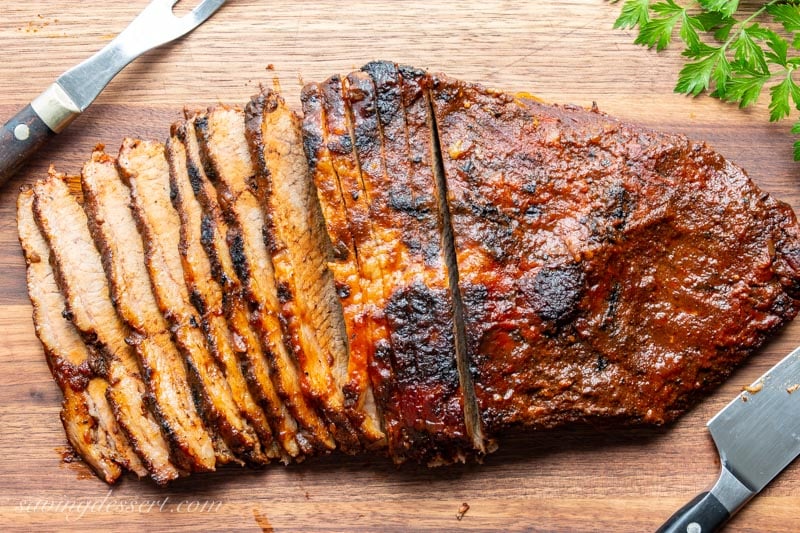
Grab your apron and let’s dive into the art of brisket BBQ—by the end, you’ll not only savor the flavors but also bask in the glory of your barbecue prowess. Ready to become a brisket boss? Let’s get cooking!
What is BBQ Brisket?
BBQ brisket is more than just a dish; it’s a celebration of flavor and patience, where tough beef is transformed into tender, juicy meat through slow cooking. Originating from the traditions of Texas barbecue, brisket is cooked over low heat for several hours. This process involves smoking the beef cut, known for its dense connective tissues, at a low temperature which breaks down these tissues into gelatin, infusing the meat with smoky flavors and making it incredibly tender.
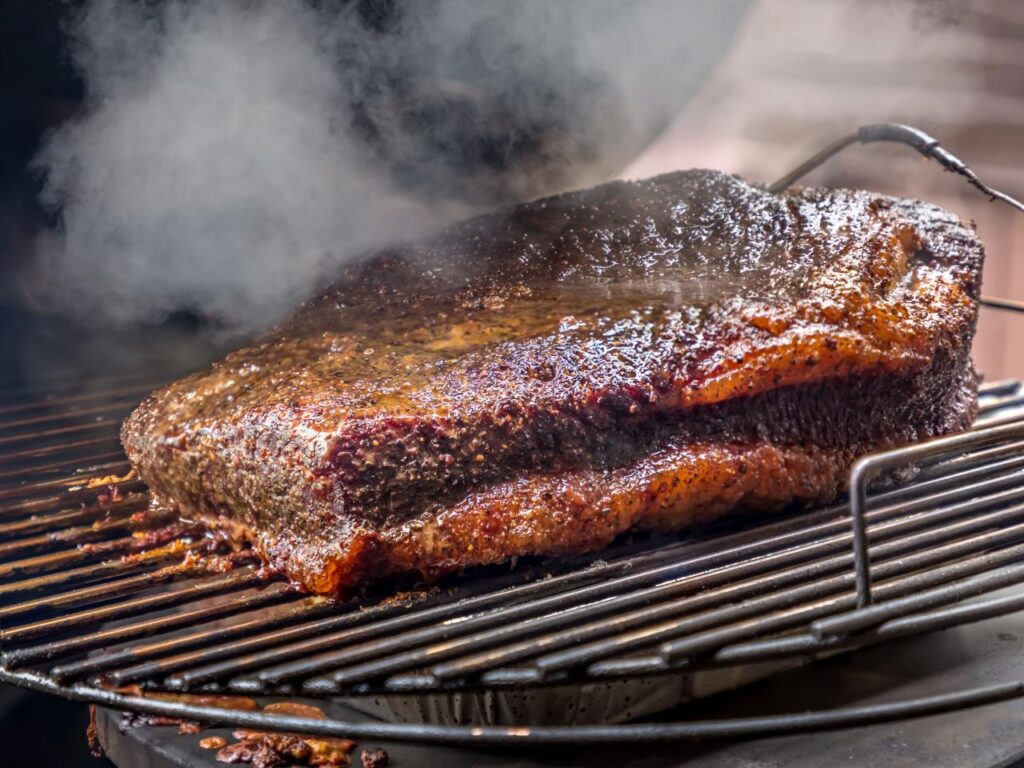
The end result? A crusty, caramelized exterior known as the “bark,” and a rich, flavorful interior that pulls apart with just a gentle tug. Whether you’re a barbecue aficionado or a novice, mastering brisket is a rewarding culinary adventure that’s steeped in tradition and taste.
What You’ll Need to Make Brisket BBQ
Embarking on your brisket BBQ journey? Here’s what you’ll need to ensure everything goes smoothly:
- Brisket: Aim for a full-packer brisket which includes both the flat and point sections. This cut offers a mix of textures and flavors.
- Trimming Tools: A sharp boning knife for trimming the fat and shaping the brisket.
- Seasoning: Basic salt and pepper are essentials; add garlic powder, onion powder, or your favorite BBQ rub for extra flair.
- Smoker: A reliable smoker that can maintain a steady low temperature between 225-250°F (107-121°C).
- Wood Chips or Chunks: Oak, hickory, or mesquite to provide that deep, smoky flavor.
- Temperature Gauge: A meat thermometer or a digital probe to monitor the brisket’s internal temperature accurately.
- Aluminum Foil or Butcher Paper: Useful for wrapping the brisket during the stall to keep it moist and reduce cooking time.
- Patience and Time: Smoking a brisket is a day-long affair, often requiring early morning starts and hours of monitoring.
With these tools and ingredients, you’re well-equipped to tackle brisket BBQ. Each plays a pivotal role in turning a tough cut into a tender, celebrated meal.
How to Prepare a Brisket for BBQ
Preparing a brisket for BBQ is an essential step in achieving that perfect smoky flavor and tender texture. Start by selecting a brisket with good marbling; this fat helps keep the meat moist during long hours of cooking.
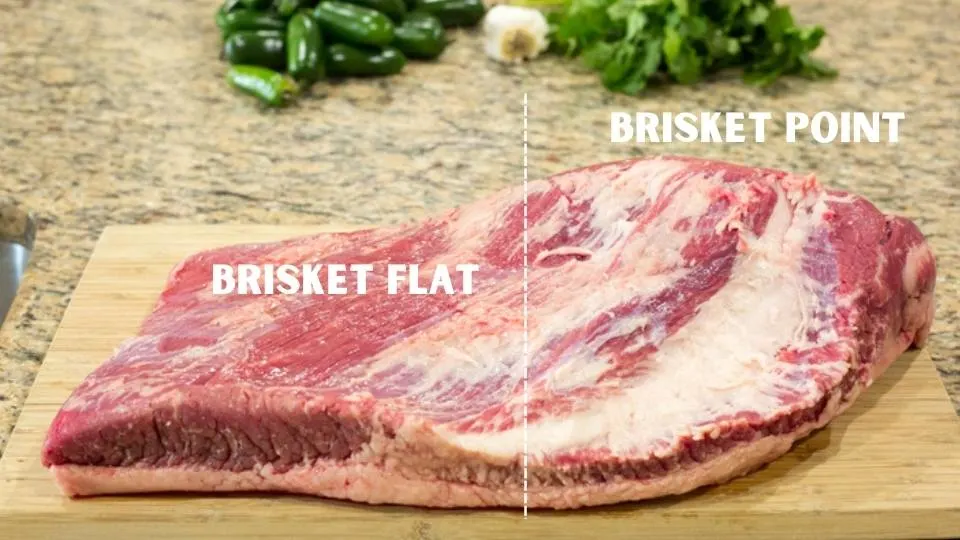
Next, you’ll want to trim the fat cap down to about a quarter-inch thick. This allows enough fat to render and moisturize the meat without leaving too much unrendered fat.
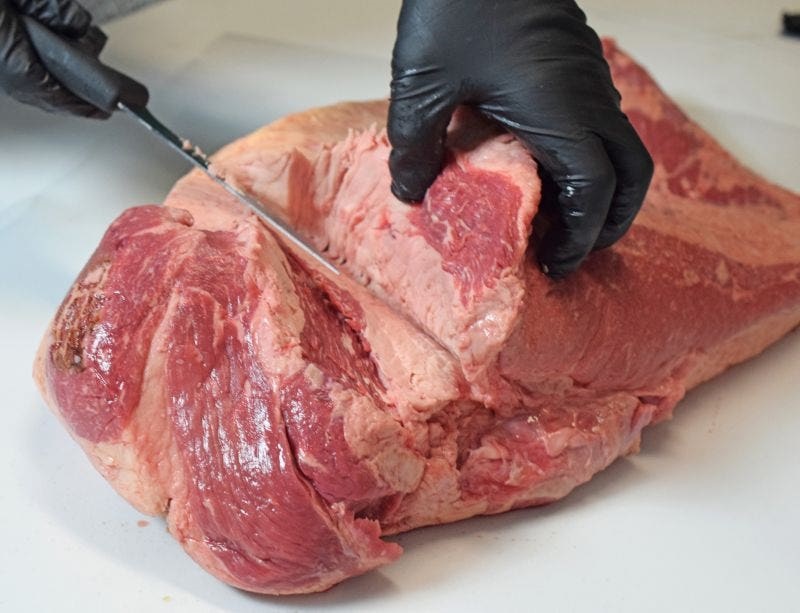
After trimming, it’s time to season. A simple yet effective rub is key. Mix equal parts kosher salt and coarse black pepper, and consider adding garlic powder or smoked paprika for extra depth. Coat the brisket evenly, massaging the spices into every nook. Some pitmasters let the brisket sit with the rub overnight in the fridge, enhancing the flavor penetration.

How Long Should You BBQ a Brisket?
The time it takes to BBQ a brisket can feel like a slow dance where patience is your partner. Generally, you’re looking at about 1 to 1.5 hours of cooking time per pound of brisket when smoking at a constant temperature of 225-250°F (107-121°C). For a full-sized brisket weighing around 12 to 15 pounds, that translates to roughly 12 to 18 hours on the smoker.
The key is not to rush it. Brisket is done not necessarily when the clock says so, but when its internal temperature reaches around 200-205°F (93-96°C). This is when the collagen within the meat has broken down sufficiently to make the brisket beautifully tender.

Always remember, each brisket behaves a bit differently based on its size and fat content, so keep a close eye on the temperature rather than the clock. And don’t forget, after smoking, give your brisket a good rest of at least one hour before slicing to let those juices redistribute.
What is the best cooking method for brisket?
Here’s a comparison of three popular methods for cooking brisket, each offering its own unique benefits and flavors:
| Cooking Method | Description | Pros | Cons |
|---|---|---|---|
| Smoking | Traditional BBQ method using a smoker to cook brisket over low heat for several hours. | Produces a rich, smoky flavor and tender texture. Creates a distinctive smoke ring and bark. | Time-consuming and requires constant temperature monitoring. Outdoor setup needed. |
| Oven | Brisket is slow-cooked in the oven, typically wrapped in foil or covered in a roasting pan. | More controlled environment, easier to maintain consistent low temperatures. Accessible for those without a smoker. | Lacks the authentic smoky flavor of traditional BBQ. |
| Slow Cooker | Brisket is cooked slowly in a crockpot, often with added liquid for moisture. | Very convenient and foolproof. Minimal monitoring required. Keeps brisket moist. | Can become too soft or mushy. Does not develop a bark or the same depth of flavor as smoking. |
Each method suits different needs and setups. Smoking is best for flavor, the oven is great for convenience without special equipment, and the slow cooker is ideal for effortless cooking.
How to Make Brisket BBQ: Step by Step Instructions
Choose Your Brisket:
Select a whole packer brisket with good marbling and a thick flat. This cut includes both the point and the flat, giving you a mix of lean and fatty meat.
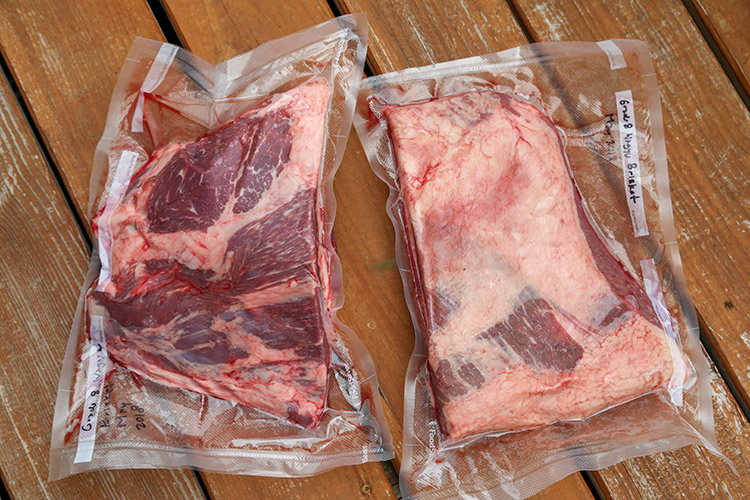
Trim the Fat:
Trim the fat cap down to about ¼ inch thick to ensure even cooking and proper fat rendering. Remove any silver skin or excess fat.

Season Generously:
Apply a liberal amount of your chosen rub—typically a mixture of salt, pepper, and other spices like garlic powder or paprika. Coat all sides evenly.

Preheat Your Smoker:
Set your smoker to maintain a temperature of around 225-250°F (107-121°C). Use wood like oak or hickory for the best flavor.

Smoke the Brisket:
Place the brisket fat side up in the smoker. Smoke until the internal temperature reaches about 200-205°F (93-96°C), which usually takes about 1 to 1.5 hours per pound.

Wrap If Necessary:
If the brisket’s exterior is getting too dark before it’s done, wrap it in butcher paper or foil to protect it and help retain moisture.
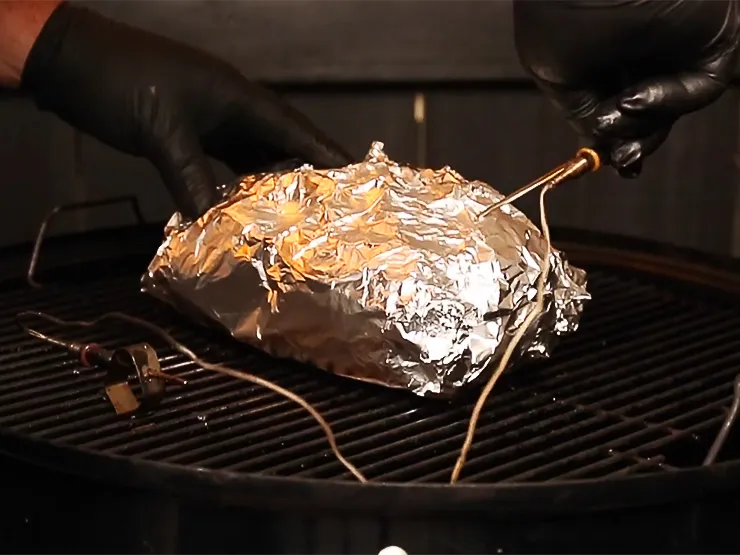
Rest the Meat & Slice Against the Grain:
Once done, remove the brisket from the smoker and let it rest for at least one hour. This allows the juices to redistribute throughout the meat, enhancing flavor and tenderness.
Cut your brisket against the grain to ensure each slice is as tender as possible. The grain in the flat and the point may run in different directions, so observe carefully.

Tips for the Recipe:
- Temperature Control: Maintaining a consistent temperature is crucial for a perfect brisket. Avoid opening the smoker too often to check the meat, as this can cause temperature fluctuations.
- Use a Meat Thermometer: A digital meat thermometer is your best friend for monitoring the brisket’s internal temperature without frequently opening the smoker.
- Let It Rest: Don’t skip the resting period. Resting the brisket allows the fibers to reabsorb the juices, making the meat moist and tender.
- Experiment with Wood: Different types of wood impart different flavors. While oak and hickory are classic, experimenting with apple or cherry can add a unique twist.
- Moisture is Key: If you’re worried about the brisket drying out, consider placing a water pan in the smoker to help maintain humidity.
Making BBQ brisket is both an art and a science, blending patience with technique to achieve that perfect smoky, tender result. From choosing a well-marbled brisket to smoking it at a controlled low temperature, each step is crucial.
The process demands attention to detail, such as properly trimming the fat and using the right wood for smoking. The magic happens slowly, as low heat coaxes out flavors and textures that are worth the wait. Remember, the journey of making brisket is as rewarding as the delicious outcome—this is not just cooking; it’s creating a masterpiece to share.
What to Serve with Beef Brisket?
Beef brisket, with its rich, smoky flavors, pairs beautifully with a variety of side dishes that complement its hearty nature. Here are some classic options to consider:
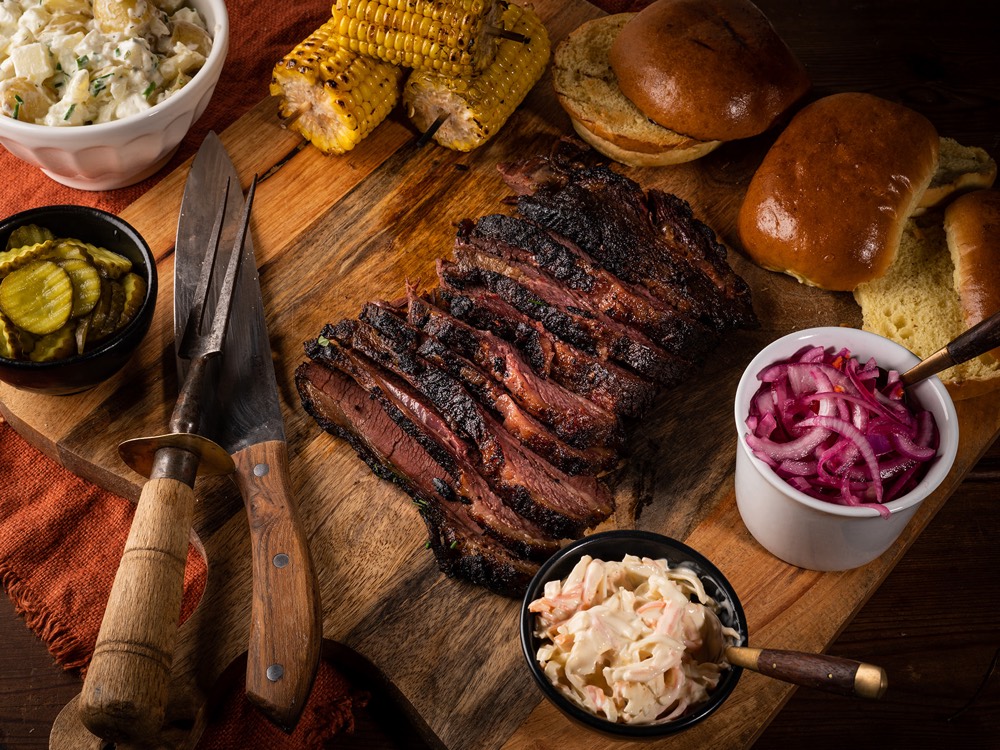
- Coleslaw: A tangy, crunchy coleslaw cuts through the richness of the brisket.
- Baked Beans: Smoky, sweet baked beans are a traditional barbecue side.
- Cornbread: Soft, buttery cornbread offers a sweet contrast to the savory meat.
- Potato Salad: A creamy or vinegar-based potato salad provides a cool, refreshing bite.
- Macaroni and Cheese: Rich and creamy, this is a comfort food favorite that goes well with brisket.
- Pickles and Onions: Adding pickles and raw onions brings a sharp, piquant flavor that balances the fatty brisket.
- Grilled Vegetables: Lightly charred vegetables add a smoky, healthy component to the meal.
What to Do with Leftover Brisket?
Leftover brisket can be incredibly versatile and even more flavorful the next day. Here’s what you can do:
- Shred It: Shred the brisket for use in sandwiches, tacos, or burritos. Gently reheat the meat, mix in some BBQ sauce if desired, and enjoy a delicious, tender filling.
- Slice for Sandwiches: Thinly slice chilled brisket and layer it on crusty bread with some coleslaw, pickles, and a smear of BBQ sauce.
- Brisket Chili: Cube or shred the brisket and stir it into a pot of chili for a rich, meaty flavor.
- Brisket Hash: Mix chopped brisket with diced potatoes, onions, and peppers for a savory breakfast hash. Top it with a fried egg for extra richness.
Recipe Notes for BBQ Brisket
- Choice of Meat: Opt for a brisket with a visible amount of marbling and a thick flat. This will ensure the meat remains moist and flavorful throughout the long cooking process.
- Rub Ingredients: Stick to simple but robust flavors. A basic rub of salt and pepper is classic, but don’t hesitate to add your own twist with ingredients like brown sugar, paprika, or cayenne for a bit of heat.
- Wood Selection: The type of wood you use can greatly influence the flavor profile of your brisket. Oak and hickory provide traditional smoky flavors, while fruit woods like apple or cherry offer a milder, sweeter taste.
- Temperature Consistency: Keeping a consistent temperature in your smoker is critical. Avoid opening the smoker frequently, as this can cause significant heat loss and extend cooking times.
- Monitoring Meat Temperature: Invest in a good quality meat thermometer to keep track of your brisket’s internal temperature without frequently opening the smoker.
- Wrapping the Brisket: Consider wrapping your brisket in butcher paper once it reaches around 150-160°F. This helps to push through the stall phase and keep the meat moist.
- Resting Time: Allow the brisket to rest for at least one hour after cooking. This helps the juices redistribute throughout the meat, ensuring that every slice is juicy and flavorful.
- Slicing: Always slice the brisket against the grain for the tenderest texture. This means cutting perpendicular to the muscle fibers, which makes the meat easier to chew.
- Serving: Serve brisket with traditional sides like coleslaw and cornbread, or try it in sandwiches or tacos for a delicious twist.
Conclusion
In wrapping up, mastering the art of BBQ brisket is a rewarding endeavor that combines patience, skill, and a touch of culinary creativity. From choosing the right cut with ample marbling to maintaining the perfect low and slow cooking environment n your smoker, each step is crucial to achieving that melt-in-your-mouth texture and smoky flavor.
Remember, the keys to a great brisket are consistent temperature control, proper meat preparation, and adequate resting time before slicing. Serve your perfectly smoked brisket with classic sides like coleslaw and baked beans, or get creative with brisket sandwiches or tacos.
Whether for a special occasion or a weekend cookout, the process of making BBQ brisket is as enjoyable as the delicious results. So fire up your smoker, gather your friends and family, and revel in the flavors of a beautifully cooked brisket.
